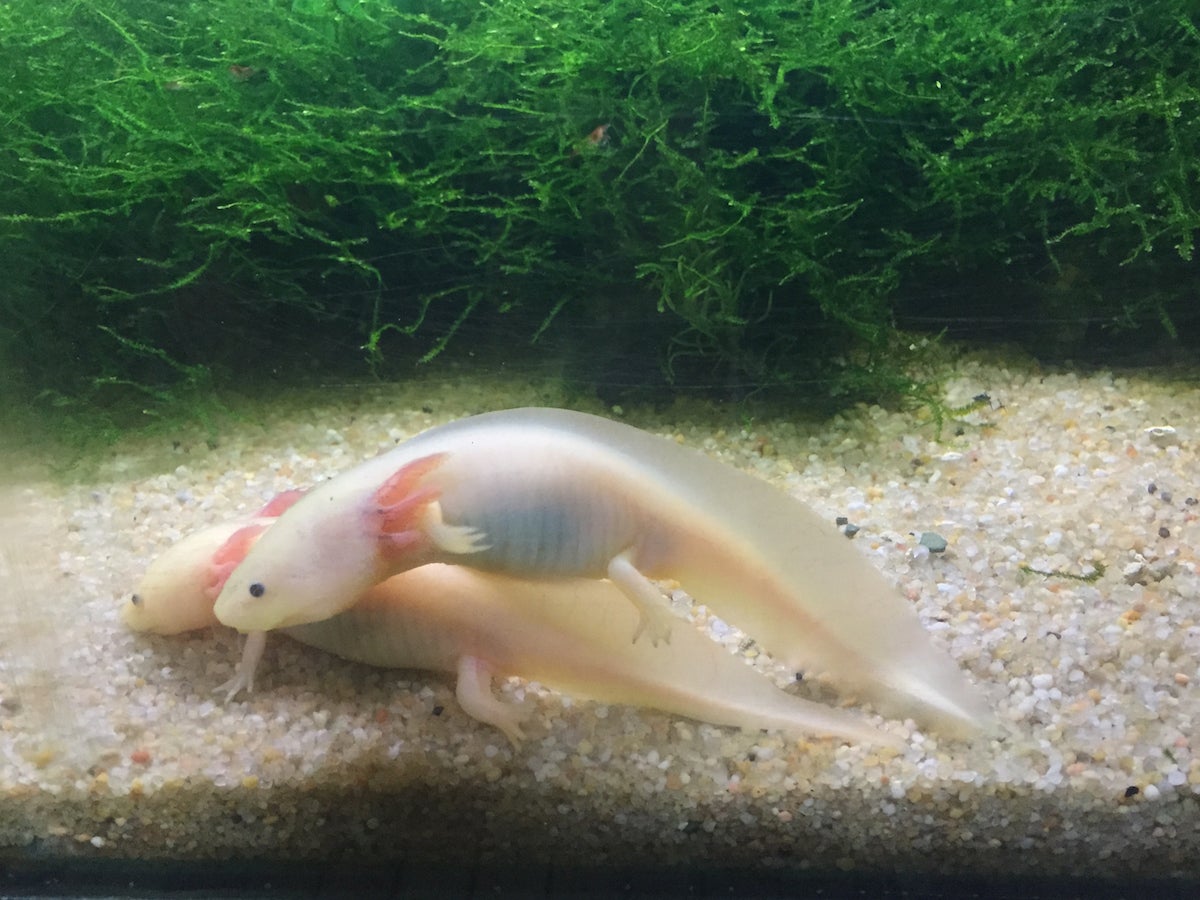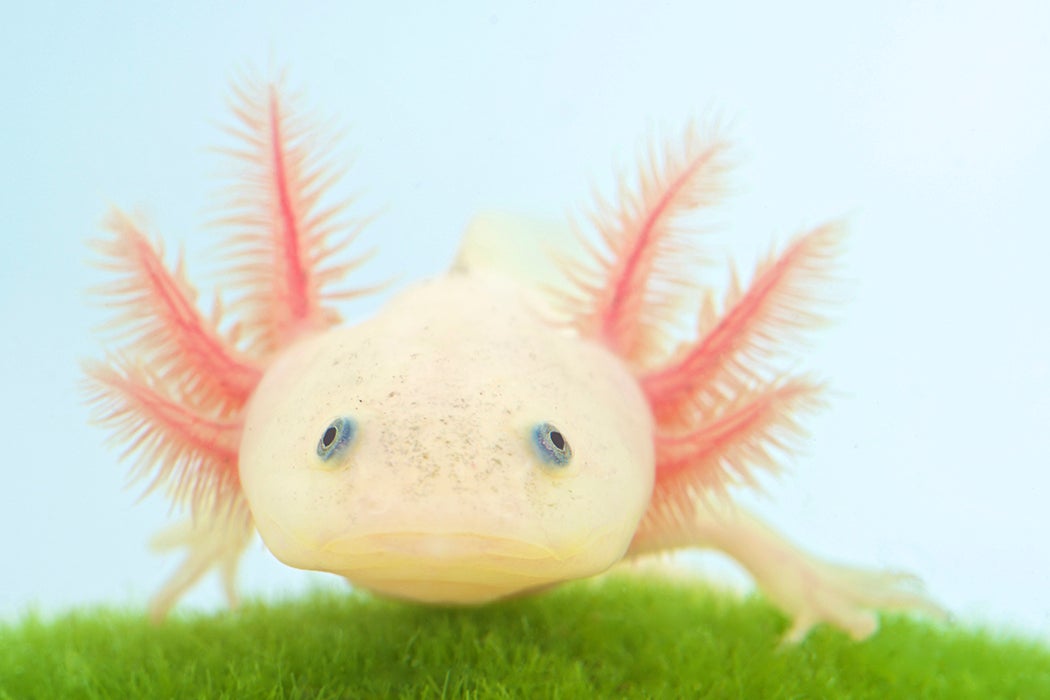The axolotl, or Ambystoma mexicanum, is the ultimate survivalist: When an axolotl loses a leg, tail, or a bit of its heart, the body part regrows and nary a scar remains. But the hardy creature is on the brink of extinction.
The axolotl is also a conservation paradox: The iconic creature is Mexico’s national symbol, and, because it breeds easily in an aquarium, a beloved pet around the globe. So many axolotls live in captivity that certain restaurants in Japan serve up the axolotl as a fried snack. Many thousands of axolotls a year are also used in scientific research: Because of their miraculous regeneration abilities, axolotls are studied in labs the world over. But in the Xochimilco canals around Mexico City, the axolotl’s only remaining natural habitat, pollution and the loss of water habitat mean that the axolotl has become a rare sight.
Humans and axolotls have long had an ambivalent relationship. When the Mexica, or “Aztecs,” settled the region around Lake Texcoco in the thirteenth century and built an island city in the middle of the lake as their capital, the axolotl thrived in and around the elaborate canal system. The animal is named after the Aztec god “Xolotl,” who is said to have transformed into an axolotl to avoid being sacrificed (though axolotls were still killed and eaten). As the Aztec empire grew, so did the capital city, and the lake shrank. All that remains of Lake Texcoco today are polluted canals and small lakes in Xochimilco, a southern district of Mexico City.
And as the wetlands disappeared, so did the axolotl. The first robust count of axolotls in 1998 estimated that around 6,000 animals lived in each square kilometer. When ecologist Luis Zambrano at the National Autonomous University of Mexico (UNAM) carried out a count in 2015, he only found only 35 per square kilometer.
This dramatic drop also threatens the axolotl where it flourishes, in aquariums and labs around the globe. In 1804, the scientist Alexander von Humboldt sent two specimens preserved in alcohol to Paris. Humboldt and other early explorers already noticed another peculiarity of the axolotl: While other salamanders metamorphose into terrestrial creatures when becoming sexually mature, axolotls hold on to their feathery gills and remain in the water their entire lives. In the words of Stephen Jay Gould, the axolotls are “sexually mature tadpoles.”
Axolotls entered laboratories when a French expedition shipped 34 of them to the Natural History Museum in Paris in 1863. Five males and one female were passed on to French zoologist Auguste Duméril, who managed to breed them with fantastic success. Duméril distributed axolotls to institutions and individuals all over Europe. Various labs have bred them over the past century, making the axolotl the oldest self-sustaining laboratory animal population.
Fascinating—and somewhat grotesque—experiments from the past 150 years brought us much information about the axolotl’s ability to regenerate and heal. For example, amputated axolotl limbs regenerate completely, and even after multiple amputations, they are as functional as the original limb. The axolotl’s cells “know” which structure to regrow: When an arm is amputated at the level of the shoulder, the entire arm regrows. But when the arm is amputated at the elbow, only the lower arm and hand regrow; when the arm is amputated at the wrist, only the hand regrows.
Other fundamental experiments delved further. When regenerating tissue is grafted from an amputated left limb to an amputated right limb, and vice versa, the axolotl curiously grows three new limbs instead of just one—two of them are so-called “supernumerary limbs.” Perhaps more astonishingly, Axolotls can receive transplanted heads without problems from rejection.
These might appear like the lab notes of a mad scientist, but the (somewhat grotesque) experiments that uncovered these regenerative abilities were an essential foundation for understanding just how regeneration works in axolotls—and why it doesn’t work in mammals. In mammals (like us humans), scars form rapidly and prevent tissue regeneration. The axolotl, on the other hand, can repair deep tissue wounds without any scarring. This is thanks to the blastema, a group of cells that cover the amputation wound. While macrophages, a type of immune cell that gobbles up dead cells, are responsible for scarring in mammals, scientists found that in the axolotl, these macrophages are essential to its remarkable wound-healing and regeneration. This blastema is also the reason why the axolotl can regrow a broken (or cut off) heart.

Researchers painstakingly deciphered how molecules orchestrate axolotl limb regeneration, though many open questions remain. But regeneration biologists are not limiting themselves to the axolotl; they have focused on understanding why mammals are so bad at regenerating. Adult mice and humans can regenerate fingertips, an ability they lose with age, giving hope that researchers may eventually reawaken our regenerative abilities.
But it is unknown how long researchers will still be able to work with the axolotl: Like many lab animals, they are highly inbred, which could threaten their survival. To measure how small a gene pool is, scientists use an “inbreeding coefficient:” identical twins have an inbreeding coefficient of 100, completely unrelated individuals a coefficient of zero. For healthy growth, a captive population should have a coefficient of 12.5 at maximum. The notoriously inbred Spanish Habsburgs had a coefficient of 20; the coefficient for axolotls is 35.
The axolotl’s high level of inbreeding is partly a result of its history. The axolotls used in labs today trace back to the five individuals shipped to Paris in 1863. From there, axolotls were distributed around Europe and later to the U.S., where the lab axolotls were occasionally crossed with wild axolotls. These axolotls form the basis for the more than 1,000 adult and young axolotls maintained at the Ambystoma Genetic Stock Center at the University of Kentucky, which ships tens of thousands axolotl embryos each year to research labs around the globe. Together with the dwindling numbers in the wild, the small gene pool conjures a perfect storm that could threaten these animals.
Disease or an accidental fire could wipe out this vulnerable population. A puzzling disease has been killing axolotl larvae in some labs, for example, and in the stock center. New gene variants that allow the axolotl to withstand the disease would be a solution. But where should new genetic variation come from, if not from the threatened wild population in Lake Xochimilco? Loss of the lab and wild populations would be a significant setback for studies in regeneration.
That would be unfortunate timing, as axolotl research just recently celebrated two breakthroughs: the application of the genetic CRISPR/Cas9 scissors and the decoding of the genome. With CRISPR/Cas9, researchers can precisely and easily modify DNA building blocks in different animals and plants. Only recently, the regeneration biologist Elly Tanaka and her team showed how they can use these scissors to selectively integrate genes into the axolotl genome. Unlike in other laboratory animals, like the mouse, zebrafish, or fruit fly, researchers had long been unable to specifically modify axolotl genes. With the CRISPR/Cas9 scissors, axolotl biologists can now mark specific cells in color and watch them during regeneration.
While the human genome was deciphered in 2003, the axolotl genome remained elusive until the beginning of 2018. The 32-gigabase-pair axolotl genome is roughly ten times bigger than the human genome—the biggest genome deciphered so far. With the axolotl’s exact genetic code in their hands, researchers can ask completely novel questions. Why can the axolotl regenerate while the mouse can’t? How has the mouse genome changed to preclude regeneration? Answers to these questions will define the strategy to try to induce regeneration in mice—and maybe in humans.
But in Lake Xochimilco, it does not look like the wild axolotl population as a whole will rebound quickly or easily. The ecologist Luis Zambrano attributes the axolotl’s rapid decline to two primary threats: non-native fish and pollution. Carp and tilapia were introduced to Xochimilco in the 1970s and 80s by programs of the Food and Agriculture Organization of the UN as part of an effort to get more protein into the local diet. But as these predatory fish thrive, they are picking off young axolotls.
Zambrano has mapped where axolotls still remain and envisions a plan in which local fishers sweep these areas of fish repeatedly, giving axolotls time to re-establish themselves. While introducing axolotls from successful lab populations might seem like an appealing idea, Zambrano cautions against it: “It is more effective to create sanctuaries in which the existing axolotls can survive and perhaps thrive,” he said.
Pollution is trickier to tackle. Whenever a storm fills Mexico City’s aging sewer systems, overflow from waste treatment systems flushes Xochimilco’s canals with ammonia, heavy metals and other toxic chemicals. Axolotls breathe, in part, through their highly permeable skin, which makes them particularly vulnerable to pollution. Although Zambrano and others, such as local zoologist Virginia Graue, have tried to increase axolotl numbers. So far, conservation efforts have not been able to turn the axolotl’s decline around.
In Julio Cortazar’s 1952 short story “Axolotl,” the narrator is enthralled by the axolotl: “The eyes of the axolotls spoke to me of the presence of a different life, of another way of seeing. Glueing my face to the glass (the guard would cough fussily once in a while), I tried to see better those diminutive golden points, that entrance to the infinitely slow and remote world of these rosy creatures.” If conservation efforts are not stepped up, this remote world may be lost forever.







